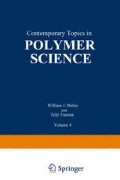Abstract
A large number of polymers involving metallic elements in the backbone and side chains have been investigated in the search for new thermostable plactics and elastomers and of excellent mechanical properties and also new polymers used as catalysts and medical materials. Major of these polymers were polymerized by radical initiators and few ones were prepared with ionic initiators on account of the lability of the carbon-metal bond. However, anionic living polymerization of some metal containing monomers were possible, which was a very interesting molecular designing method for polymers with uniform molecular weights, block copolymers and star and comb-shaped polymers. Nametkin et al. reported that the alkyl lithium initiated anionic polymerization of vinyl trialkyl silanes were free of termination, though not entirely clear1). According to Pittman and Hirao, anionic living polymerization of ferrocenylmethyl methacrylate could be initiated with LiAlH4 and with poly-α-methylstyrene living anion at a temperature below -78°C though the reaction condition and catalytic efficiency were limmited2). Recently, another anionic living polymer of p-triphenyltinstyrene has been found to be stable up to -32°C and to form the block copolymer with α-methylstyrene3). The stabilities of anionic propagating ends of these monomers would depend upon the inertness of the carbon-metal bonds of the respective monomers towards the carbanions.
Access this chapter
Tax calculation will be finalised at checkout
Purchases are for personal use only
Preview
Unable to display preview. Download preview PDF.
References
Nametkin, N. S., S. G. Durgaryan, and V. G. Filippova, Dokl. Akad. Nauk, SSSR, 172 1090 (1967)
Pittman, Jr. U. C., and A. Hirao, J. Polymer Sci. Chem. Ed., 16, 1197 (1978)
Yamazaki, N., S. Nakahama, A. Hirao, J. Goto, Y. Shiraishi, F. Martinez, and H. M. Pung, J. Macromol. Sci. Chem. in the press.
Noltes, J. G., H. A. Budding, and G. J. M. Van der Kerk, Ree. Trav. Chim., 79, 408(1960)
Seyferth, D., New Application of Organometallic Reagents in Organic Synthesis, Elsevier Scientific Publishing Co., Amsterdam-Oxford-New York, p161 (1976)
Author information
Authors and Affiliations
Editor information
Editors and Affiliations
Rights and permissions
Copyright information
© 1984 Plenum Press, New York
About this chapter
Cite this chapter
Yamazaki, N., Nakahama, S., Hirao, A., Shiraishi, Y., Phung, H.M. (1984). Anionic Polymerization of p-Styrenyl Substituted Derivatives of Silicon, Germanium and Tin. In: Bailey, W.J., Tsuruta, T. (eds) Contemporary Topics in Polymer Science. Springer, Boston, MA. https://doi.org/10.1007/978-1-4615-6743-1_26
Download citation
DOI: https://doi.org/10.1007/978-1-4615-6743-1_26
Publisher Name: Springer, Boston, MA
Print ISBN: 978-1-4615-6745-5
Online ISBN: 978-1-4615-6743-1
eBook Packages: Springer Book Archive

